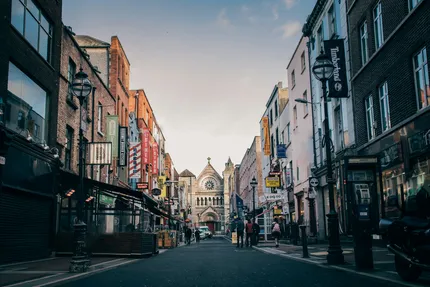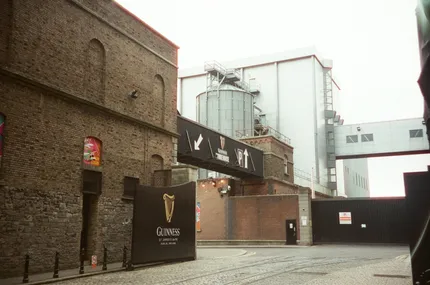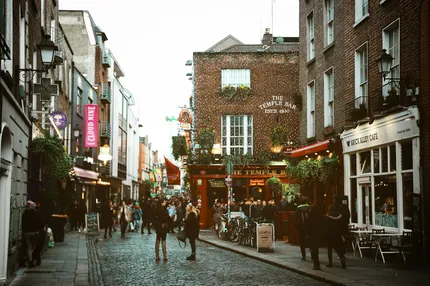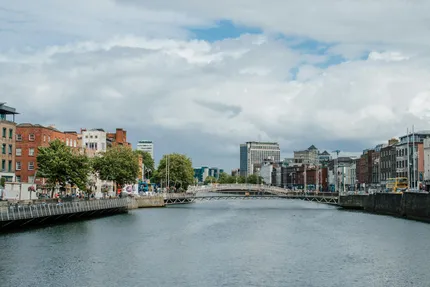CityTouring

City trip to Dublin
IrelandDublin, the vibrant capital of Ireland, is a city that effortlessly blends a rich historical past with a lively and modern cultural scene. Known for its warm hospitality, picturesque landscapes, and literary heritage, Dublin is an inviting destination for travelers. The city is renowned for its dynamic street life, with lively pubs, traditional music, and friendly locals creating an unmistakable ambiance.
Stroll through the cobbled streets of Temple Bar, visit the legendary Trinity College to view the Book of Kells, or explore Dublin Castle and learn about the country's history. Dublin also offers a flourishing arts scene with world-class museums and galleries, like the National Gallery of Ireland and the Irish Museum of Modern Art. The city's proximity to natural beauty, such as the serene Dublin Bay and the lush Phoenix Park, makes it a unique blend of urban charm and outdoor allure.
Full travel plans for a city trip to Dublin

Guinness Storehouse
The Guinness Storehouse in Dublin offers an immersive experience exploring the history of Ireland's iconic stout. Visitors can learn about the brewing process, advertising legacy, and the brand’s global journey since 1759. Conclude your visit at the Gravity Bar on the rooftop for spectacular 360-degree views of Dublin city while enjoying a complimentary pint of Guinness.

Trinity College and the Book of Kells
Trinity College Dublin houses the Book of Kells, a renowned medieval manuscript created by monks in the 9th century. This illuminated manuscript, known for its intricate artistry, is on permanent display in the college's Old Library. A visit includes access to the impressive Long Room, filled with 200,000 of the library's oldest books, showcasing Irish history and scholarship.

Temple Bar District
Temple Bar District in Dublin is a vibrant cultural quarter known for its lively atmosphere and cobblestone streets. It features a mix of trendy pubs, live music venues, galleries, and restaurants, making it a popular spot for both tourists and locals. The area hosts a variety of cultural events and markets, offering a taste of Dublin's artistic and social scene.
Dublin is an ideal destination for a wide range of travelers, particularly those interested in history, culture, and literature. It's perfect for literature buffs wishing to trace the paths of famous writers like James Joyce and W.B. Yeats. The city's literary tours and bookshops offer an immersive experience into its storied past. History enthusiasts will enjoy the old-world charm and historic landmarks, including Kilmainham Gaol and Christ Church Cathedral.
For foodies and social butterflies, Dublin's diverse culinary scene and bustling nightlife provide plenty of entertainment and delight, from local Irish cuisine to vibrant pubs with live traditional music. The city is also well-suited for family travelers, with attractions like Dublin Zoo and the National Museum of Ireland offering engaging experiences for all ages. For outdoor enthusiasts the areas around the City offer some great views and hiking opportunities on the shore, for example in Howth, or in the backcountry.
Three top reasons for a city trip to Dublin
- Explore the rich history of Dublin at Trinity College Library, home to the ancient Book of Kells, and soak in its impressive Long Room's stunning architecture.
- Walk through the vibrant Temple Bar district, known for its traditional pubs, art galleries, and cultural events, offering a lively insight into Dublin's nightlife and artistic scene.
- Visit the Guinness Storehouse for an interactive experience on brewing, its history, and enjoy a pint with panoramic views of Dublin from the Gravity Bar.

Best time to visit Dublin
The best time to visit Dublin is during late spring to early autumn (April to September). This period offers mild weather, lively festivals, and plenty of outdoor activities, making it ideal for exploring both the city and its scenic surroundings.
More activities and things to see in Dublin:
Trip to Howth
A trip to Howth offers a scenic escape from Dublin city, featuring stunning coastal views, picturesque cliffs, and abundant wildlife. Visitors can explore the Howth Cliff Walk, enjoy fresh seafood at local restaurants, and visit the historic Howth Castle. The quaint fishing village also features a lively market and opportunities for spotting seals and seabirds along the harbor.
Dublin Castle
Dublin Castle, a historic site dating back to the 13th century, is a key landmark in Dublin's city center. Originally a defensive fortification, it now serves as a government complex and tourist attraction. Visitors can explore its medieval towers, opulent State Apartments, and learn about Ireland's history through various exhibits. It's a blend of architecture, from medieval to modern.
St. Stephen's Green
St. Stephen's Green is a historic public park in Dublin's city center, offering 22 acres of serene greenery and colorful gardens. Ideal for a leisurely stroll, the park features ornamental lakes, sculptures, and a Victorian bandstand. Its accessible paths and picturesque settings make it an oasis for both locals and visitors seeking relaxation amid Dublin's bustling streets.
Kilmainham Gaol
Kilmainham Gaol in Dublin is a former prison turned museum that played a crucial role in Irish history. Opened in 1796, it held many notable Irish leaders and revolutionaries. A visit offers insights into Ireland's fight for independence, featuring exhibitions and a guided tour through its haunting corridors and cells, where historical narratives are vividly brought to life.
Grafton Street
Grafton Street in Dublin is a bustling shopping area known for its vibrant atmosphere. It's lined with a variety of shops, from high-end boutiques to popular chain stores, along with numerous cafes and restaurants. The street is also famous for its street performers, offering live music and entertainment that adds to the lively ambiance, making it a must-visit for both tourists and locals.
Phoenix Park
Phoenix Park in Dublin is one of the largest enclosed public parks in any capital city in Europe. Covering 1,752 acres, it offers vast green spaces, walking and cycling paths, and is home to the Dublin Zoo and Áras an Uachtaráin, the residence of the President of Ireland. Visitors can enjoy its expanses, ornamental gardens, and the wild deer that freely roam the park.
National Museum of Ireland
The National Museum of Ireland in Dublin offers a fascinating glimpse into the country's rich heritage. Explore extensive collections ranging from prehistoric artifacts to modern Irish history. The museum features exhibitions on archaeology, decorative arts, and natural history. Highlights include the Treasury, with Celtic and Medieval treasures, and the Viking Ireland section, showcasing artifacts from Viking settlements across Ireland.
Ha'penny Bridge
Ha'penny Bridge, a cast-iron pedestrian bridge built in 1816, spans Dublin's River Liffey. Originally known as the Wellington Bridge, it is famed for its history and unique structure. Its name derives from the half-penny toll that was once required to cross. The bridge is an iconic symbol of Dublin, offering picturesque views and connecting the city's cultural hubs.
Getting around in Dublin
Dublin is a relatively compact city, making it easy to explore on foot or by bicycle. The Dublin Bikes scheme offers convenient bike rentals throughout the city. Public transport is a practical option, with Dublin Bus, Luas tram services, and the DART train system connecting the city center with suburbs and coastal areas. The Leap Card is a convenient electronic ticket that can be used across most public transport options. Taxis and ride-sharing services like Uber and Bolt are widely available but may be more cost-effective for short trips or when carrying heavy luggage. Overall, Dublin is walkable and efficiently navigable without a car, though renting one may be beneficial for exploring areas outside the city, such as the scenic countryside or coastal routes.
Getting to Dublin
Dublin is highly accessible via various modes of transportation. Dublin Airport, located about 10 kilometers north of the city center, serves as the main gateway, offering extensive international and domestic flight connections across Europe, North America, and the Middle East. Key airlines such as Aer Lingus, Ryanair, and several international carriers operate from here. For those preferring rail travel, Dublin is connected via Irish Rail to other major cities in Ireland. While direct international rail services are unavailable, you can connect through Belfast or ferry services to the UK. Long-distance buses operated by companies like Bus Éireann and GoBus provide services across Ireland and can access Britain via ferry links. Thus, whether flying, taking a train, or a long-distance bus, Dublin is well-served by multiple transportation means, making it a conveniently reachable destination.